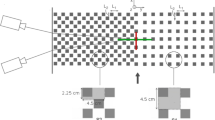Abstract
The paper presents a theoretical model to compute the end depth of a free overfall in steeply sloping rough rectangular channels. A momentum equation based on the Boussinesq approximation is applied to obtain the equation of the end depth. The effect of streamline curvature at the free surface is utilized to develop the differential equation for the flow profile upstream of the free overfall of a wide rectangular channel. As direct solutions for the end depth and flow profile cannot be obtained owing to implicit forms of the developed equations, an auto-recursive search scheme is evolved to solve these equations simultaneously. A method for estimation of discharge from the known end depth and Nikuradse equivalent sand roughness is also presented. Results from the present model correspond satisfactorily with experimental observations except for some higher roughnesses.
Similar content being viewed by others
References
Ali K H M, Sykes A 1972 Free-vortex theory applied to free overfall. J. Hydraul. Div., Am. Soc. Civ. Eng. 98: 973–979
Anastasiadou-Partheniou L, Hatzigiannakis E 1995 General end-depth-discharge relationship at free overfall in trapezoidal channel. J. Irrig. Drain. Eng., Am. Soc. Civ. Eng. 121: 143–151
Anderson M V 1967 Non-uniform flow in front of a free overfall. Acta Polytech. Scand. 42: 1–24
ASCE Task Force 1963 Friction factor in open channels. J. Hydraul. Div., Am. Soc. Civ. Eng. 89: 97–143
Bauer S W, Graf W H 1971 Free overfall as flow measuring device. J. Irrig. Drain. Div., Am. Soc. Civ. Eng. 97: 73–83
Chow V T 1959 Open channel hydraulics (New York: McGraw-Hill)
Chow W L, Han T 1979 Inviscid solution for the problem of the free overfall. J. Appl. Mech. 46: 1–5
Clausnitzer B, Hager W H 1997 Outflow characteristics from circular pipe. J. Hydraul. Eng., Am. Soc. Civ. Eng. 123: 914–917
Clarke N S 1965 On two-dimensional inviscid flow in a waterfall. J. Fluid Mech. 22: 359–369
Conte S D, de Boor C 1987 Elementary numerical analysis: An algorithmic approach (New York: McGraw-Hill)
Davis A C, Ellett B G S, Jacob R P 1998 Flow measurement in sloping channels with rectangular free overfall. J. Hydraul. Eng., Am. Soc. Civ. Eng. 124: 760–763
Davis A C, Jacob R P, Ellett B G S 1999 Estimating trajectory of free overfall nappe. J. Hydraul. Eng., Am. Soc. Civ. Eng. 125: 79–82
Delleur J W, Dooge J C I, Gent K W 1956 Influence of slope and roughness on the free overfall. J. Hydraul. Div., Am. Soc. Civ. Eng. 82: 30–35
Dey S 1998a Free overfall in rough rectangular channels: a computational approach. Water, Maritime Energy, Proc. Inst. Civ. Eng. (London) 130: 51–54
Dey S 1998b End depth in circular channels. J. Hydraul. Eng., Am. Soc. Civ. Eng. 124: 856–863
Diskin M H 1961 The end depth at a drop in trapezoidal channels. J. Hydraul. Div., Am. Soc. Civ. Eng. 87: 11–32
Fathy A, Shaarawi M A 1954 Hydraulics of free overfall. Proc. ASCE 80, Reston: 1–12
Ferro V 1992 Flow measurement with rectangular free overfall. J. Irrig. Drain. Eng., Am. Soc. Civ. Eng. 118: 956–970
Ferro V 1999 Theoretical end-depth-discharge relationship for free overfall. J. Irrig. Drain. Eng., Am. Soc. Civ. Eng. 125: 40–44
Gupta R D, Jamil M, Mohsin M 1993 Discharge prediction in smooth trapezoidal free overfall (positive, zero and negative slopes). J. Irrig. Drain. Eng., Am. Soc. Civ. Eng. 119: 215–224
Hager W H 1983 Hydraulics of the plane overfall. J. Hydraul. Eng., Am. Soc. Civ. Eng. 109: 1683–1697
Jaeger C 1957 Engineering fluid mechanics (New York: St. Martin’s Press)
Keller R J, Fong S S 1989 Flow measurements with trapezoidal free overfall. J. Irrig. Drain. Eng., Am. Soc. Civ. Eng. 115: 125–136
Kraijenhoff D A, Dommerholt A 1977 Brink depth method in rectangular channel. J. Irrig. Drain. Div., Am. Soc. Civ. Eng. 103: 171–177
Marchi E 1993 On the free overfall. J. Hydraul. Res. 31: 777–790
Markland E 1965 Calculation of flow at a free overfall by relaxation method. Proc. Inst. Civ. Eng. (London) 31: 71–78
McCormick J M, Salvadori M G 1964 Numerical methods in Fortran (New Jersey: Prentice-Hall)
Montes J S 1992 A potential flow solution for the free overfall. Water, Maritime Energy, Proc. Inst. Civ. Eng. (London) 96: 259–266
Murty B S 1994 End depth in trapezoidal and exponential channels. J. Hydraul. Res. 32: 219–232
Naghdi P M, Rubin M B 1981 On inviscid flow in a waterfall. J. Fluid Mech. 103: 375–387
Rajaratnam N, Muralidhar D 1964a End depth for exponential channels. J. Irrig. Drain. Div., Am. Soc. Civ. Eng. 90: 17–36
Rajaratnam N, Muralidhar D 1964b End depth for circular channels. J. Hydraul. Div., Am. Soc. Civ. Eng. 90: 99–119
Rajaratnam N, Muralidhar D 1968a Characteristics of rectangular free overfall. J. Hydraul. Res. 6: 233–258
Rajaratnam N, Muralidhar D 1968b The rectangular free overfall. J. Hydraul. Div., Am. Soc. Civ. Eng. 94: 849–850
Rajaratnam N, Muralidhar D 1970 The trapezoidal free overfall. J. Hydraul. Res. 8: 419–447
Rajaratnam N, Muralidhar D, Beltaos S 1976 Roughness effects on rectangular overfall. J. Hydraul. Div., Am. Soc. Civ. Eng. 102: 599–614
Rouse H 1936 Discharge characteristics of the free overfall. Civ. Eng. 6: 257–260
Schlichting H 1960 Boundary layer theory (New York: McGraw-Hill)
Smith C D 1962 Brink depth for a circular channel. J. Hydraul. Div., Am. Soc. Civ. Eng. 88: 125–134
Streikoff T, Moayeri M S 1970 Pattern of potential flow in a free overfall. J. Hydraul. Div, Am. Soc. Civ. Eng. 96: 879–901
Author information
Authors and Affiliations
Rights and permissions
About this article
Cite this article
Dey, S. End depth in steeply sloping rough rectangular channels. Sadhana 25, 1–10 (2000). https://doi.org/10.1007/BF02703802
Received:
Revised:
Issue Date:
DOI: https://doi.org/10.1007/BF02703802




